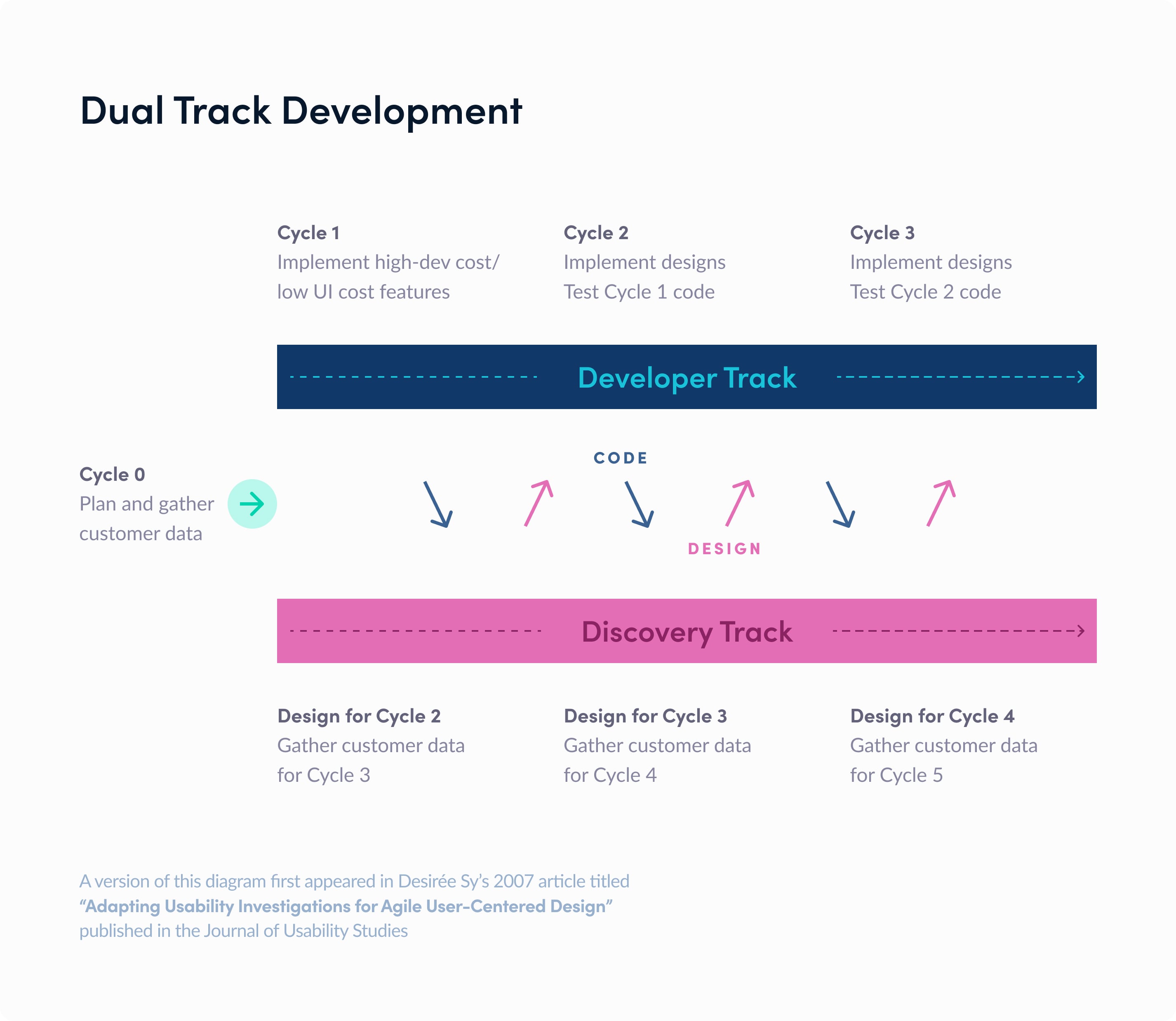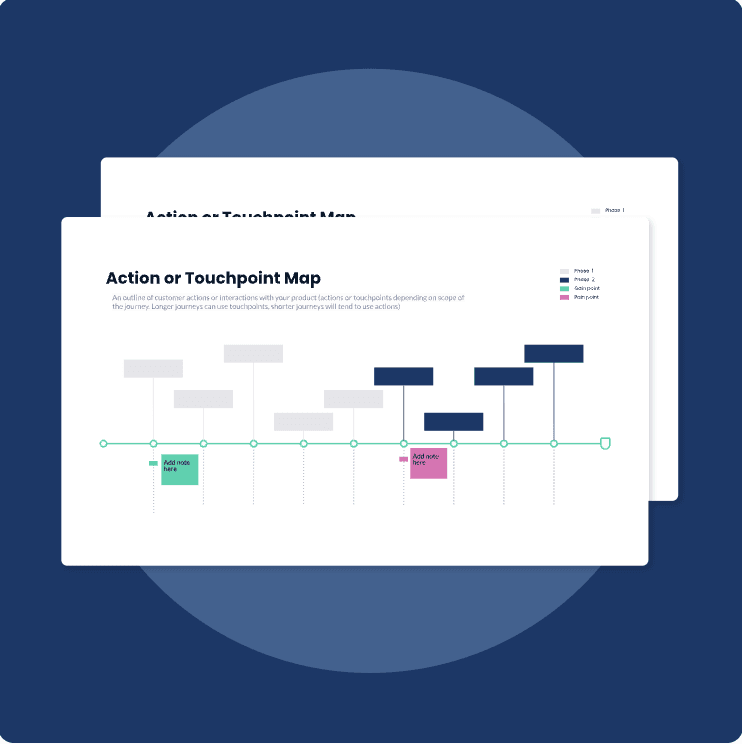Updated: June 24, 2025- 8 min read
Agile methodologies, originating in the early 2000s, continue to evolve to tackle new challenges today. Originating with frameworks like Scrum and Kanban, Agile's iterative approach emphasizes cross-functional teamwork and rapid feedback loops.
The concept of Dual-Track Agile owes its beginnings to a paper by Desiree Sy, then at Autodesk, published in 2007. Jeff Patton, author of User Story Mapping popularized the approach through his writing and courses.
Dual-track agile combines continuous discovery and delivery into parallel tracks, enhancing Agile's capacity for efficient, responsive, and customer-centric product development. One of the most lauded benefits of dual-track agile is that it brings developers into the product discovery process by placing an emphasis on product outcomes.
Instead of developers considering their job done as soon as they deliver the product, they respond in real time to user feedback and new pain points as they surface. Teams never stop learning, which means Discovery never stops, nor does Development when the Dual-Track Agile process weaves together both aspects.
Playbook: The Dangers of Staying Safe
Check out insights from Mastercard Gateway CPO to help you battle cumbersome processes and become truly Agile.
GET THE PLAYBOOK
Understanding Dual-Track Agile: Core Principles and Framework
Dual-Track Agile is a methodology designed to integrate market and usability research (Discovery) continuously with the building products (Delivery). The core principle of Dual-Track Agile is to ensure that the product team is not just building the product right (efficiency in Delivery) but also building the right product. This approach allows teams to validate ideas through experiments and user feedback before full-scale development, reducing risks and aligning product features with user needs.
The most expensive way to test your idea is to build production quality software.
— Jeff Patton
In dual-track development, only the features that are researched and tested move into full production, with the same feature handed back and forth between the two tracks multiple times before the final draft comes to life.
As you can see below, Sy breaks down each track into 4 cycles:

Cycle 0:
Plan and gather customer data. You’ll notice that this first step isn’t assigned to either track. Dual-track agile includes everyone in the initial discovery phase.
Cycle 1:
Developers get started in the foundational coding that requires little input from design
Designers get to work designing for Cycle 2
Product managers gather data for Cycle 3
Cycle 2:
Developers implement 1st round of designs
Designers work on Cycle 3 designs based on 3rd data set
QA testers review Cycle 1 code
PMs gather data for Cycle 4
Cycle 3:
Developers implement 2nd round of designs
Designers work on Cycle 4 designs based on 3rd set of data set
QA testers review Cycle 2 code
PMs gather data for Cycle 5
Notice that there is no “done column”. The cycles continue until the desired outcomes are reached.
Dual Track Development: Distinguishing Between Discovery and Delivery
In the Discovery track, teams focus on identifying user problems and validating potential solutions through prototypes, user interviews, and testing. This track is about learning fast and adapting based on real user insights.
The Delivery track, on the other hand, involves taking validated ideas and implementing them into shippable product increments, using typical Agile practices like sprints and iterations.
When both tracks operate in parallel, ongoing communication and collaboration ensure that insights from Discovery directly influence the priorities and tasks in Delivery. This symbiotic relationship accelerates the development process and enhances product relevance and quality.
Agile Discovery Process
In Dual-Track Agile, product discovery is pivotal, serving as the foundation for continuous innovation. This phase is about understanding what the user truly needs, which helps in defining the problems accurately and crafting appropriate solutions. Continuous innovation is fueled by a cycle of hypothesizing, experimenting, and validating, ensuring that every feature developed is both desirable and viable. The agility of this process means that discovery is never complete but is an ongoing quest for improvement and adaptation.
Tools and Techniques for Effective Agile Discovery Process
Effective agile discovery relies on a variety of tools and techniques designed to uncover deep insights into user behavior and preferences.
Product discovery methods include:
User flow mapping
User Flow Template
Include design early in the Product process with these two user flow diagram templates.
Get the template
Customer journey mapping
Free Customer Journey Map
Put yourself in your customers’ shoes to find the problems in your user experience (and uncover opportunities to solve them).
Download here
User personas
Free User Persona Template
Get to know your users to build the right solution for the right audience.
Get Yours Now
Leveraging User Feedback in Agile Discovery
User feedback is the cornerstone of the agile discovery process. Engaging with users through interviews, surveys, and direct observation provides invaluable insights that drive product development. Feedback mechanisms should be built into every stage of the product lifecycle to capture diverse user interactions and responses.
Prototyping: Creating low-fidelity or high-fidelity prototypes to simulate features and test them with users.
User Interviews: Conducting in-depth discussions with users to explore their needs, experiences, and reactions to concepts.
Usability Testing: Observing users as they interact with the product in a controlled setting to identify usability issues and areas for improvement.
A/B Testing: Comparing two versions of a product feature to see which one performs better in terms of user engagement and satisfaction.

Beta Testing: Releasing the product to a limited audience outside the company to receive real-world usage feedback before launch.
Surveys and Questionnaires: Distributing surveys to gather quantitative and qualitative data using internal features or external software to collect feedback from users while they use the product.
Implementing a Dual-Track System: Roles and Responsibilities
Successful implementation of Dual-Track Agile hinges on clearly defined roles and responsibilities. The Discovery team, typically comprising product managers, UX designers, business analysts, focuses on understanding user needs and testing hypotheses.
The Delivery team, consisting of software developers, QA engineers, and DevOps, is tasked with turning validated ideas into production-ready features. Regular cross-functional meetings ensure alignment and foster collaboration, allowing insights and feedback to flow seamlessly between teams.
To understand design, you need to get beyond the basic schedule and really understand what happens at each phase—research, concept development, and how design is maintained through engineering. It's about building bridges between different cultures and organizations.
— Robert Brunner, Chief Designer at Beats by Dr. Dre in The Product Podcast: The Designer Behind Apple’s $1.5 Billion Success
Backlog Management in a Dual-Track Agile Framework
Managing the backlog effectively is critical in Dual-Track Agile. The Discovery backlog should focus on big-picture items that drive product strategy, such as market research and hypothesis testing, while the Delivery backlog handles more granular tasks like feature development and bug fixes.
Prioritization should be dynamic, with regular backlog grooming sessions to adjust to new insights and ensure both tracks are focused on delivering maximum user and business value. Integrating feedback mechanisms into both backlogs ensures that the product evolves in response to real user data.
Synchronizing Dual Track Scrum for Optimal Outcomes
The success of Dual-Track Agile hinges on the seamless integration and synchronization between the discovery and delivery tracks. Effective synchronization allows teams to pivot quickly based on feedback, reduce waste by halting the development of unwanted features, and accelerate the market readiness of features that meet real user needs.
Synchronization strategies:
Regular Integration Meetings: Weekly or bi-weekly sessions where discovery and delivery teams align on findings and adjust backlogs.
Shared Documentation: Utilizing tools like Coda or shared drives to maintain live documents that both teams can access and update.
Cross-Functional Mini-Teams: Forming dynamic sub-teams from both tracks to tackle specific features or problems, enhancing mutual understanding and cooperation, a là Spotify.
Dual-Track Agile Use Case: Collaborate Now and Save Time Later
Imagine that at a digital news subscription service, the marketing team was eager to introduce a 25% discount for annual subscribers, hoping to increase revenue and reduce churn. The idea was well-received during customer validation and seemed straightforward given its popularity among competitors. However, when presented to the engineering team, the proposal precipitated a slew of logistical and technical questions.
The engineering team wanted to know about the scalability of the discount structure, asking if this would set a precedent for future promotions, and what mechanisms would be needed to manage these discounts dynamically. The marketing and product teams grew antsy as the dialogue turned technical. They pushed for expedited development, asserting that the feature should be straightforward given its apparent simplicity and proven market success.
Feeling the pressure, the development team created a one-off workable solution that lacked a robust framework to support modifications or expansions.
When the marketing team returned the next quarter to introduce a BOGO promo to attract new users, they discovered that the initial setup was too rigid to be adapted.
The engineers had to start again from square one, much to the dismay of the marketing team who lamented the slow turnaround for what they expected to be “simple updates”.
This story is all too common and is exactly what a dual-track system combats. Instead of the development team delivering something “that works”, they could be focused on delivering something focused on outcomes. In the case above, that would be a robust promotional architecture that can adapt to changing markets, user preferences, and business objectives.
In turn, a discovery team working within a dual-track agile framework understands that the only good ideas are ones that can be delivered within a reasonable timeframe and scope.
Dual-Track Development: 2 Tracks, Infinite Outcomes
When everyone is focused on the same important goal, then working together becomes much more seamless. This goal isn’t simply handing over a solution or hitting a metric. Rather, it’s something that everyone works toward continuously. In fact, objectives themselves are meant to change along with organizations. What doesn’t change is the desire to learn and improve.
Design Sprint Template
Use design thinking to solve design problems and reduce production risks.
GET THE TEMPLATE
Updated: June 24, 2025




